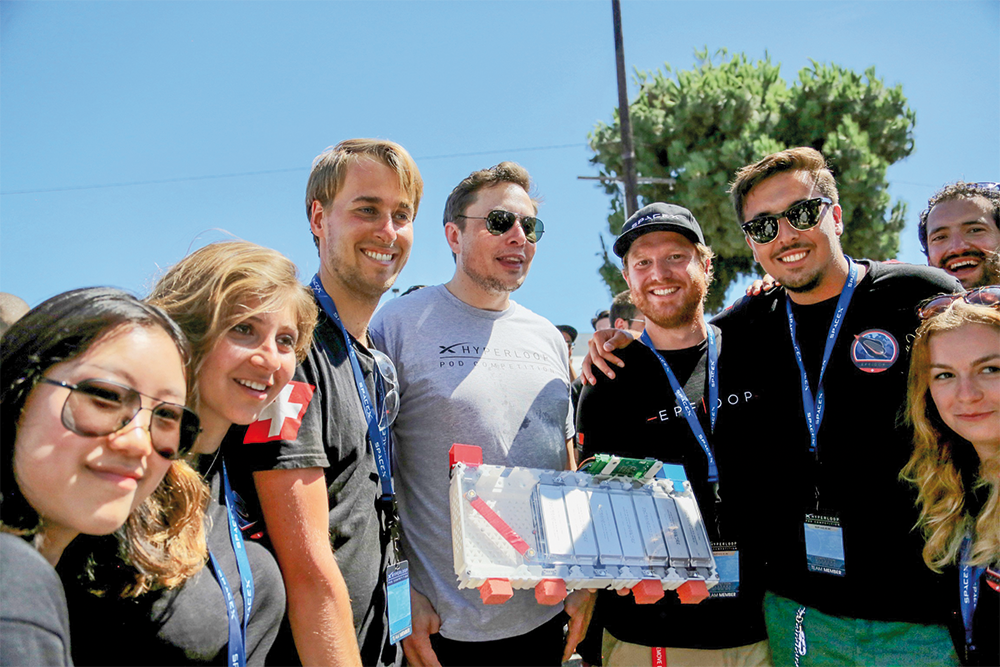In the Heart of Elon Musk's student competition

By the time they arrived at SpaceX’s premises in Hawthorne (California) at the end of July, the EPFLoop team had already won an incredible technological race.
In just a matter of months, the students designed and built the prototype of a pod that SpaceX engineers have selected among 18 others, out of the thousands of projects that they had received from all over the world.
The team leader is Denis Tudor, a 24-year-old Romanian PhD student in electrical engineering. He himself had already run in the Hyperloop Pod competition launched by Elon Musk, but with another team. For EPFLoop, the team set up by the Swiss Federal Institute of Technology in Lausanne (EPFL), this was a first. Around 50 students with various specialities (mechanics, aerodynamics, electronics, software, avionics) have participated in the project and 35 of them travelled to California.
The EPFL invested the necessary resources. The software was designed and tested (including a test with a 230kg flying motion wheel to imitate the pod’s mass inertia). The propulsion system was tested on rails laid on the campus grounds. Unlike the “real” Hyperloop, the race does not use magnetic levitation — the SpaceX tube, which is only a mile long, is too short for accelerating in levitation. On the other hand, the vacuum is still present and the students have designed a pressure vessel to protect critical components that would not withstand the vacuum in the tube. “Vacuum is THE major constraint for Hyperloop,” emphasized Denis Tudor. “A vacuum environment generates differential force problems. Without appropriate equipment, there is no chance.”.
During the week before the speed competition, SpaceX engineers analyse and rate each project with great severity. “They put a lot of pressure on you by asking a host of questions. They are some of the world’s best rocket engineers. You must follow the procedures and be extremely professional.” EPFLoop’s work made a great impression: the Swiss prototype neglected no detail and it was declared “best engineered product” which sealed their qualification for the speed competition on Sunday.

On Saturday evening, the three finalists were entitled to test runs over 300m of the tube. Launched at half power, the EPFLoop pod exceeded 200km per hour, which was very encouraging: it would be able to run much faster over the full length of the tube. Based on their calculations, the students confidently decided to increase the tensile force on the wheel by 30% and targeted 500km per hour. “We knew what we were doing” said Denis Tudor, who nevertheless had problems falling asleep that night.
On Sunday, the Dutch team from Delft University were the first to launch their pod. Due to engine problems, it couldn’t exceed 120km per hour. Once the tube was depressurised and the pod removed, it was EPFLoop’s turn to run. This was when Elon Musk himself suddenly showed up in person to have a chat with the Swiss students. “He is not like he’s presented by the media,” says Denis Tudor. “A really nice guy who’s pretty straightforward. A businessman, who’s technically very strong.”
After 40 minutes’ discussion with the billionaire, the Swiss pod was prepared. The vacuum was applied and the systems verified. Off we go! After only 5m, the pod was already racing at 60km per hour. However, this breakneck acceleration melted the wheel’s coating.
The students had not been aware that the new wheel mounted the day before did not have the same coating as the one used for the test runs. It disintegrated and the wheel lost traction. The EPFLoop pod did not exceed 85km per hour and finished third in the speed competition. Recorded at a speed of 466km per hour, the German WAAR Hyperloop team from the University of Munich won the race, just as they had done twice before.
Denis Tudor was disappointed, but not overly. His team got the official feedback from SpaceX by e-mail praising the very clean design, the incredibly well engineered product, the very good braking design, the thorough testing before competition. “We can be very proud of ourselves!”
For the young engineer, such a competition is a unique experience. “Starting off with the design and carrying it through to the end is the best training for an engineer. Moreover, competition has always boosted innovation!” He firmly believes in the feasibility of Hyperloop, a means of transport that he nicely describes as: “as fast as a plane, as convenient as a train”. Investors may not get their money back before long. “But we can only measure the benefits of such large-scale projects on the long term”, he added. “In any case, it will make technology progress. The journey matters even more than the destination.”


